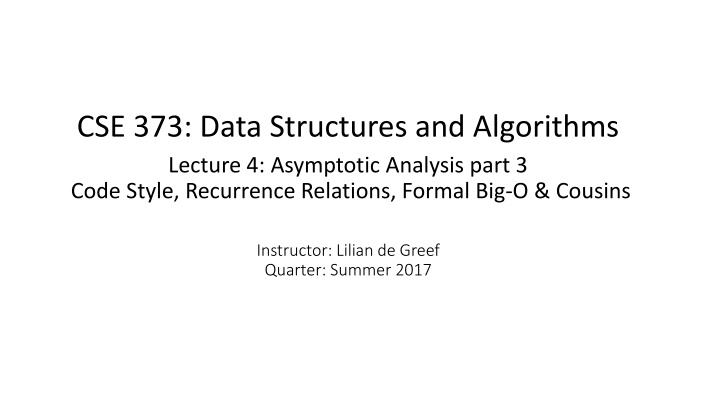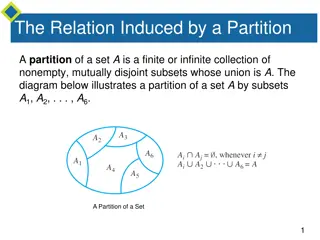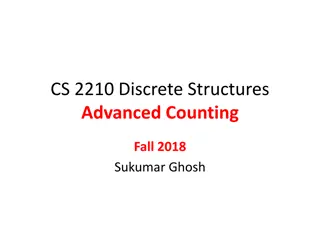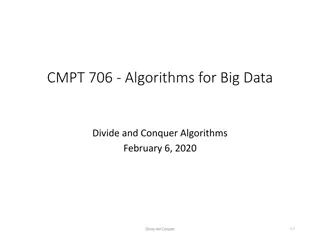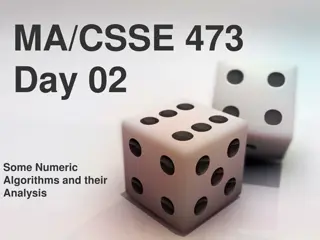Data Structures and Algorithms: Code Style, Recurrence Relations, and Big-O Analysis
Dive into the significance of code style and learn how to calculate Big-O for recursive functions through recurrence relations. Explore examples like Towers of Hanoi and Binary Search to grasp these concepts effectively.
Download Presentation

Please find below an Image/Link to download the presentation.
The content on the website is provided AS IS for your information and personal use only. It may not be sold, licensed, or shared on other websites without obtaining consent from the author.If you encounter any issues during the download, it is possible that the publisher has removed the file from their server.
You are allowed to download the files provided on this website for personal or commercial use, subject to the condition that they are used lawfully. All files are the property of their respective owners.
The content on the website is provided AS IS for your information and personal use only. It may not be sold, licensed, or shared on other websites without obtaining consent from the author.
E N D
Presentation Transcript
CSE 373: Data Structures and Algorithms Lecture 4: Asymptotic Analysis part 3 Code Style, Recurrence Relations, Formal Big-O & Cousins Instructor: Lilian de Greef Quarter: Summer 2017
Code Style Why does code style matter?
Code Style Do Don t
Recurrence Relations How to calculate Big-O for recursive functions! (Continued from last lecture)
Example #1: Towers of Hanoi // Prints instructions for moving disks from one // pole to another, where the three poles are // labeled with integers "from", "to", and "other". // Code from rosettacode.org public void move(int n, int from, int to, int other) { if (n == 1) { System.out.println("Move disk from pole " + from + " to pole " + to);} else { move(n - 1, from, other, to); move(1, from, to, other); move(n - 1, other, to, from); } }
Example #1: Towers of Hanoi if (n == 1) { System.out.println("Move disk from pole " + from + " to pole " + to);} else { move(n - 1, from, other, to); move(1, from, to, other); move(n - 1, other, to, from); }
Base Case: Recurrence Relation: (Example #1 continued)
Example #2: Binary Search 2 3 5 16 37 50 73 75 126 Find an integer in a sorted array (Can also be done non-recursively) // Requires the array to be sorted. // Returns whether k is in array. public boolean find(int[]arr, int k){ return help(arr,k,0,arr.length); } private boolean help(int[]arr, int k, int lo, int hi) { int mid = (hi+lo)/2; // i.e., lo+(hi-lo)/2 if(lo==hi) return false; if(arr[mid]==k) return true; if(arr[mid]< k) return help(arr,k,mid+1,hi); else return help(arr,k,lo,mid);
What is the recurrence relation? // Requires the array to be sorted. // Returns whether k is in array. public boolean find(int[]arr, int k){ return help(arr,k,0,arr.length); } private boolean help(int[]arr, int k, int lo, int hi) { int mid = (hi+lo)/2; // i.e., lo+(hi-lo)/2 if(lo==hi) return false; if(arr[mid]==k) return true; if(arr[mid]< k) return help(arr,k,mid+1,hi); else return help(arr,k,lo,mid); A. 2T(n-1) + 3 C. T(n/2) + 3 B. T(n-1)*T(n-1) + 3 D. T(n/2) * T(n/2) + 3
Base Case: Recurrence Relation: (Example #2 continued)
Recap: Solving Recurrence Relations 1. Determine the recurrence relation. What is the base case? T(n) = 3 + T(n/2) T(1) = 3 2. Expand the original relation to find an equivalent general expression in terms of the number of expansions. T(n) = 3 + 3 + T(n/4) = 3 + 3 + 3 + T(n/8) = = 3k + T(n/(2k)) 3. Find a closed-form expression by setting the number of expansions to a value which reduces the problem to a base case n/(2k) = 1 means n = 2k means k = log2n So T(n) = 10 log2n + 8 (get to base case and do it) So T(n) is O(logn)
Common Recurrence Relations Should know how to solve recurrences but helps to recognize some common ones: T(n) = O(1) + T(n-1) T(n) = O(1) + 2T(n/2) T(n) = O(1) + T(n/2) T(n) = O(1) + 2T(n-1) T(n) = O(n) + T(n-1) T(n) = O(n) + T(n/2) T(n) = O(n) + 2T(n/2) linear linear logarithmic O(log n) exponential quadratic linear (why?) O(n log n)
Big-O Big Picture with its formal definition
In terms of Big-O, which function has the faster asymptotic running time? f(n) worst-case running time g(n) n 0 1 2 3 4 5 6 7 8
In terms of Big-O, which function has the faster asymptotic running time? g(n) worst-case running time f(n) n 0 100 200 300 400 500 600 700 800
In terms of Big-O, which function has the faster asymptotic running time? f(n) worst-case running time g(n) n 0 500 1000 1500 2000 2500 3000 3500 4000 Take-away:
Formal Definition of Big-O General Idea explanation from last week: Mathematical upper bound describing the behavior of how long a function takes to run in terms of N. (The shape as N ) Formal definition of Big-O:
Using the Formal Definition of Big-O Definition: f(n) is in O( g(n) ) if there exist constants c and n0 such that f(n) c g(n) for all n n0 To show f(n) is in O( g(n) ), pick a clarge enough to cover the constant factors and n0large enough to cover the lower-order terms Example: Let f(n) = 3n2+18 and g(n) = n5 Example: Let f(n) = 3n2+18 and g(n) = n2
Practice with the Definition of Big-O Let f(n) = 1000n and g(n) = n2 What are some values of c and n0 we can use to show f(n) O(g(n))? Definition: f(n) is in O( g(n) ) if there exist constants c and n0 such that f(n) c g(n) for all n n0
More Practice with the Definition of Big-O Let a(n) = 10n+3n2 and b(n) = n2 What are some values of c and n0 we can use to show a(n) O(b(n))? Definition: f(n) is in O( g(n) ) if there exist constants c and n0 such that f(n) c g(n) for all n n0
Constants and Lower Order Terms The constant multiplier c is what allows functions that differ only in their largest coefficient to have the same asymptotic complexity Example: Eliminate lower-order terms because Eliminate coefficients because 3n2 vs 5n2 is meaningless without the cost of constant-time operations Can always re-scale anyways Do not ignore constants that are not multipliers! n3 is not O(n2), 3nis not O(2n)
Cousins of Big-O Big-O, Big-Omega, Big-Theta, little-o, little-omega
Big-O & Big-Omega Big-O: f(n) is in O( g(n) ) if there exist constants c and n0 such that f(n) c g(n) for all n n0 Big- : f(n) is in ( g(n) ) if there exist constants c and n0 such that f(n) c g(n) for all n n0
Big-Theta Big- : f(n) is in ( g(n) ) if f(n) is in both O(g(n)) and (g(n))
little-o & little-omega little-o: f(n) is in o( g(n) ) if constants c >0 there exists an n0 s.t. f(n) c g(n) for all n n0 little- : f(n) is in ( g(n) ) if constants c >0 there exists an n0 s.t. f(n) c g(n) for all n n0
Big-O, Big-Omega, Big-Theta Which one is more useful to describe asymptotic behavior? A common error is to say O( f(n) ) when you mean ( f(n) ) A linear algorithm is in both O(n) and O(n5) Better to say it is (n) That means that it is not, for example O(log n)
Analyzing Worst-Case Cheat Sheet Basic operations take some amount of constant time Arithmetic (fixed-width) Assignment Access one Java field or array index etc. (This is an approximationof reality: a very useful lie ) Control Flow Time Required Consecutive statements Sum of time of statement Conditionals Time of test plus slower branch Loops Method calls Sum of iterations * time of body Time of call s body Recursion Solve recurrence relation
Comments on Asymptotic Analysis Is choosing the lowest Big-O or Big-Theta the best way to choose the fastest algorithm? Big-O can use other variables (e.g. can sum all of the elements of an n-by-m matrix in O(nm))
